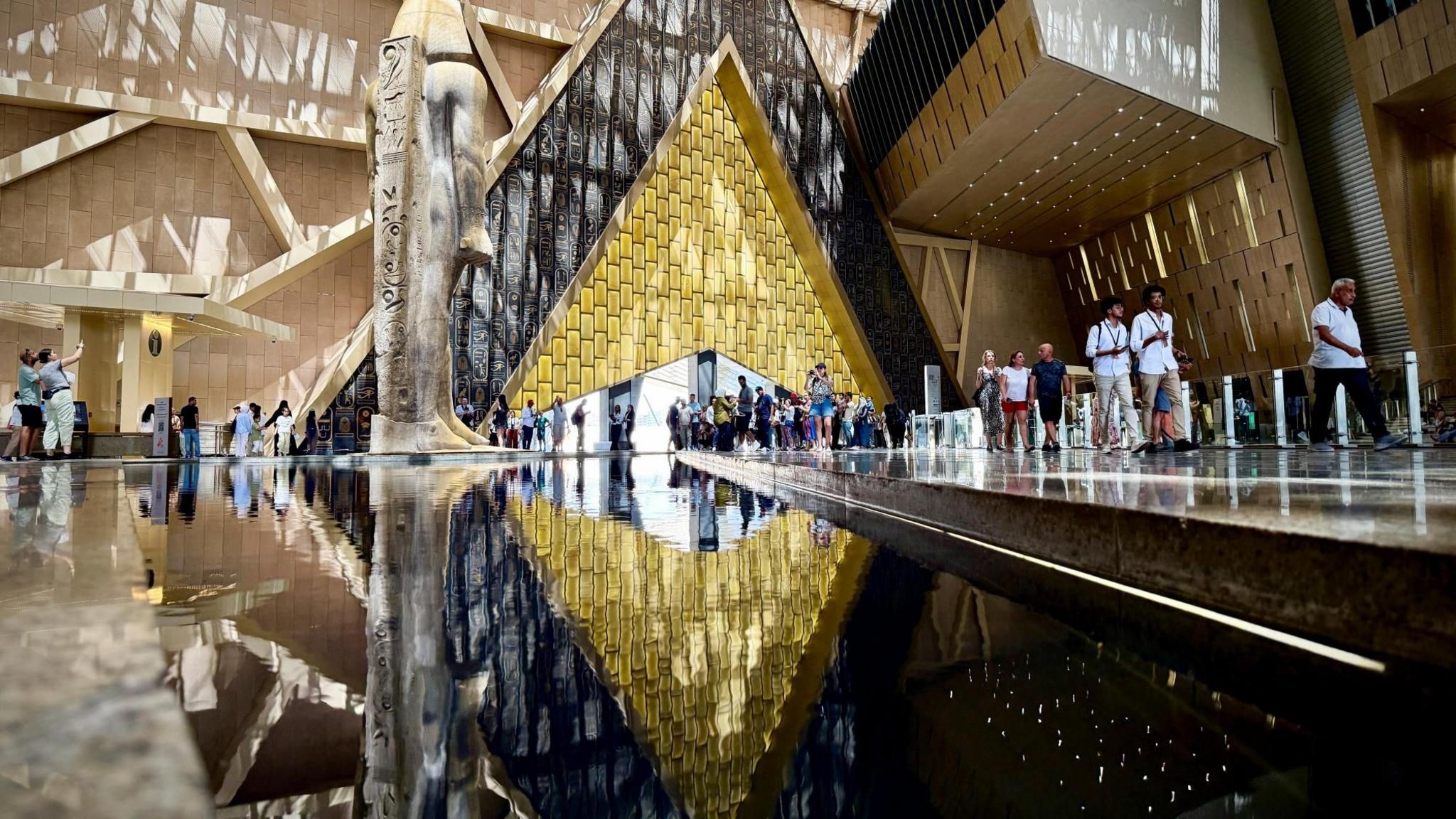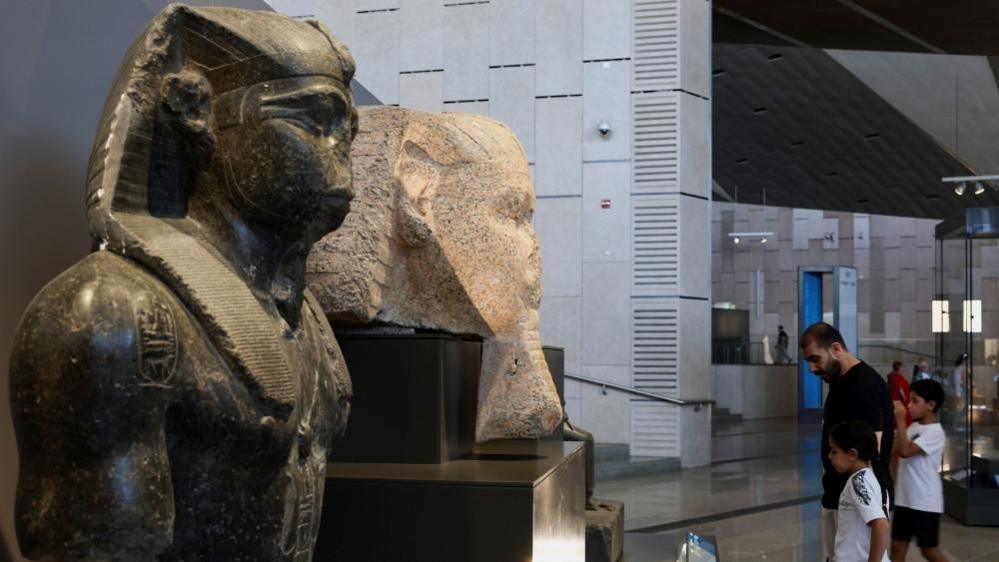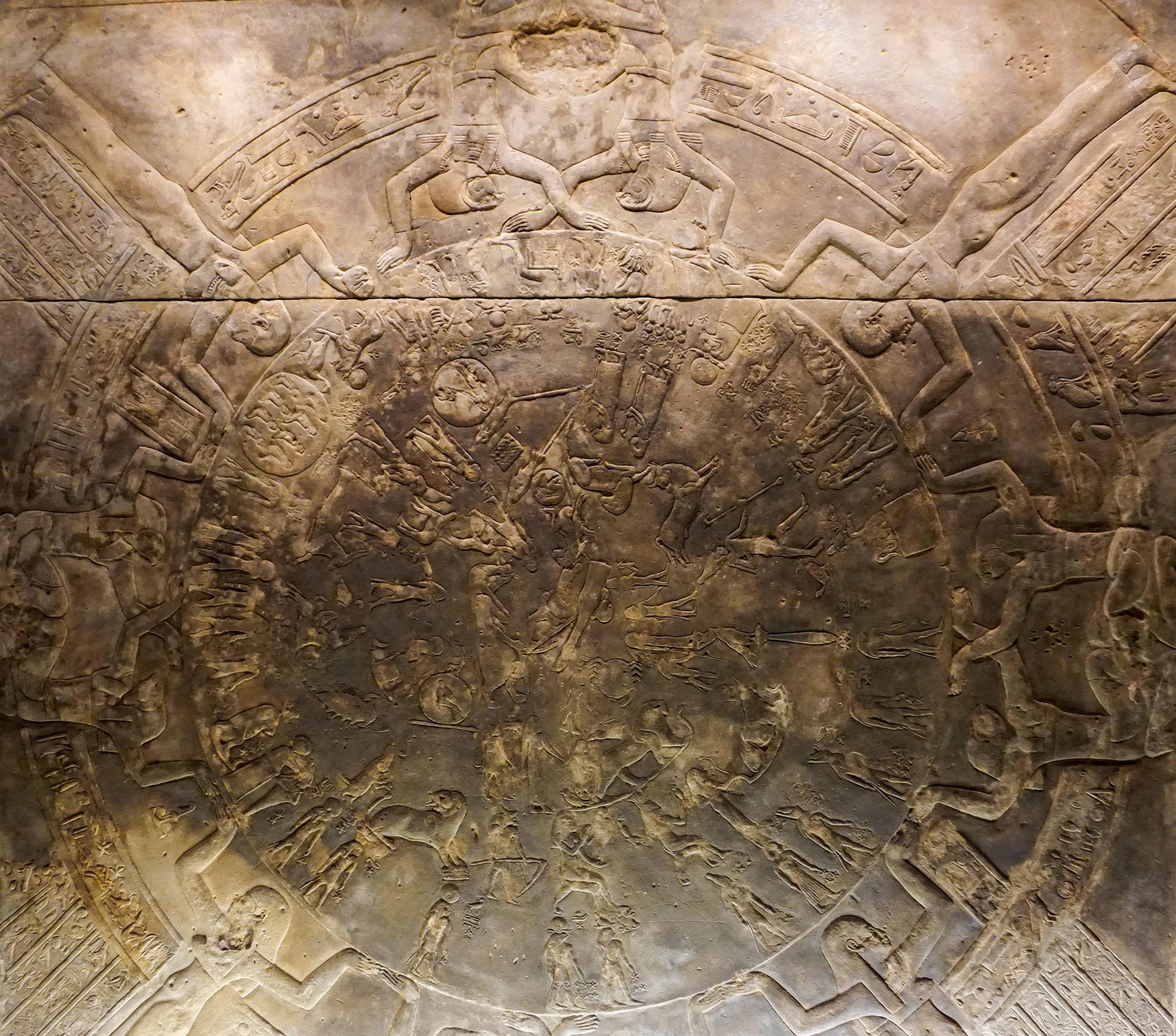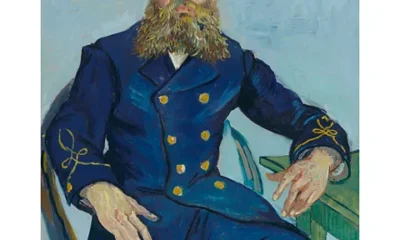Art & Culture
Egypt’s Grand Museum opens, displaying Tutankhamun tomb in full for first time

Yolande Knell, Middle East correspondent, Reporting fromin Cairo, and Wael Hussein, Reporting fromin Cairo
- Published1 November 2025, 01:19 GMT
Near one of the Seven Wonders of the Ancient World – the Great Pyramid of Khufu at Giza – Egypt is officially opening what it intends as a cultural highlight of the modern age.
The Grand Egyptian Museum (GEM), described as the world’s largest archaeological museum, is packed with some 100,000 artefacts covering some seven millennia of the country’s history from pre-dynastic times to the Greek and Roman eras.
Prominent Egyptologists argue that its establishment strengthens their demand for key Egyptian antiquities held in other countries to be returned – including the famed Rosetta Stone displayed at the British Museum.
A main draw of the GEM will be the entire contents of the intact tomb of the boy king Tutankhamun, displayed together for the first time since it was found by British Egyptologist Howard Carter. They include Tutankhamun’s spectacular gold mask, throne and chariots.

“I had to think, how can we show him in a different way, because since the discovery of the tomb in 1922, about 1,800 pieces from a total of over 5,500 that were inside the tomb were on display,” says Dr Tarek Tawfik, president of the International Association of Egyptologists and former head of the GEM.
“I had the idea of displaying the complete tomb, which means nothing remains in storage, nothing remains in other museums, and you get to have the complete experience, the way Howard Carter had it over a hundred years ago.”
Costing some $1.2bn (£910m; €1.1bn), the vast museum complex is expected to attract up to 8m visitors a year, giving a huge boost to Egyptian tourism which has been hit by regional crises.
“We hope the Grand Egyptian Museum will usher in a new golden age of Egyptology and cultural tourism,” says Ahmed Seddik, a guide and aspiring Egyptologist by the pyramids on the Giza Plateau.
Apart from the Tutankhamun exhibit and a new display of the spectacular, 4,500-year-old funerary boat of Khufu – one of the oldest and best-preserved vessels from antiquity – most of the galleries at the site have been opened to the public since last year.
“I’ve been organising so many tours to the museum even though it was partially open,” Ahmed continues. “Now it will be at the pinnacle of its glory. When the Tutankhamun collection opens, then you can imagine the whole world will come back, because this is an iconic Pharoah, the most famous king of all antiquity.”
“It’s an absolute must-see,” says Spanish tourist, Raúl, who is awaiting the full public opening on 4 November.
“We’re just waiting to go and check out all of the Egyptian artefacts,” says Sam from London, who is on an Egypt tour. “It’s a once in a lifetime opportunity.”

Another British tourist says she previously saw the Tutankhamun exhibits on display at the neoclassical Egyptian Museum in bustling Tahrir Square.
“The old museum was pretty chaotic, and it was a bit confusing,” she comments. “Hopefully the Grand Museum will be a lot easier to take in and I think you will just get more out of it.”
The new museum is colossal, spanning 500,000 square metres (5.4m sq ft) – about the size of 70 football pitches. The exterior is covered in hieroglyphs and translucent alabaster cut into triangles with a pyramid shaped entrance.
Among the GEM showstoppers are a 3,200-year-old, 16m-long suspended obelisk of the powerful pharaoh, Ramesses II, and his massive 11m-high statue. The imposing statue was moved from close to the Cairo railway station in 2006, in a complex operation in preparation for the new institution.
A giant staircase is lined with the statues of other ancient kings and queens and on an upper floor a huge window offers a perfectly framed view of the Giza pyramids.
The museum was first proposed in 1992, during the rule of President Hosni Mubarak, and construction began in 2005. It has now taken nearly as long to complete as the Great Pyramid, according to estimates.

The project was hit by financial crises, the 2011 Arab Spring – which deposed Mubarak and led to years of turmoil – the Covid-19 pandemic, and regional wars.
“It was my dream. I’m really happy to see this museum is finally opened!” Dr Zahi Hawass, Egypt’s former long-time minister of tourism and antiquities, tells the BBC. The veteran archaeologist says it shows that Egyptians are equals of foreign Egyptologists when it comes to excavations, preservation of monuments and curating museums.
“Now I want two things: number one, museums to stop buying stolen artefacts and number two, I need three objects to come back: the Rosetta Stone from the British Museum, the Zodiac from the Louvre and the Bust of Nefertiti from Berlin.”
Dr Hawass has set up online petitions – attracting hundreds of thousands of signatures – calling for all three items to be repatriated.
The Rosetta Stone, found in 1799, provided the key to deciphering hieroglyphics. It was discovered by the French army and was seized by the British as war booty. A French team cut the Dendera Zodiac, an ancient Egyptian celestial map, from the Temple of Hathor in Upper Egypt in 1821. Egypt accuses German archaeologists of smuggling the colourfully painted bust of Nefertiti, wife of Egyptian pharaoh Akhenaten, out of the country more than a century ago.
“We need the three objects to come as a good feeling from these three countries, as a gift, as Egypt gave the world many gifts,” Dr Hawass says.

Another leading Egyptologist, Dr Monica Hanna, names the same objects, “taken under a colonialist pretext”, as ones which must be repatriated. She adds: “The GEM gives this message that Egypt has done its homework very well to officially ask for the objects.”
The British Museum told the BBC that it had received “no formal requests for either the return or the loan of the Rosetta Stone from the Egyptian Government”.
Egyptian Egyptologists voice their excitement about the new museum becoming a centre for academic research, driving new discoveries.
Already, Egyptian conservators based there have painstakingly restored items belonging to Tutankhamun, including his impressive armour made of textiles and leather. According to Egyptian law, such restorations can only be done by Egyptians.
“Colleagues from around the world have been in awe of the fantastic conservation work that has been done,” says Dr Tawfik, adding that the entire project is a source of great national pride. “As well as ancient Egyptian history, we are also showcasing modern Egypt because it’s Egypt that built this museum.”
This article is taken from BBC News https://www.bbc.co.uk/news/articles/ckg4q403rpzo
Art & Culture
What’s Cooking: A Lively Dance of Flames and Flavors in the Heart of a Homely Kitchen — A Whimsical Reflection by Zeenat Iqbal Hakimjee from Harmony

la Ra Rum go the prancing, dancing,
Flames of the stove,
Amused by this scenario, is the meat
Being cooked above.
The groin softens to the warmth of the fire,
With the cabbage and potato.
It forms an empire.
The unveiling of the platter,
Reveals, fit for a king, matter.
Copied from television this recipe
Is a treat, When near and dear ones,
Altogether do meet.
Art & Culture
PAKISTAN PRESENTS LANDMARK ISLAMIC ARTWORK TO OXFORD CENTRE FOR ISLAMIC STUDIES

PAKISTAN HIGH COMMISSION
LONDON
Press Release
The Government of Pakistan presented a major contemporary Islamic artwork to the Oxford Centre for Islamic Studies, marking the first-ever representation of Pakistan in the Centre’s permanent collection.
The gift was presented by High Commissioner, Dr. Mohammad Faisal, along with his spouse Dr. Sarah Naeem, in a graceful event that was attended by Lord Wajid Khan, academics and scholars, faculty of OCIS, officers of Pakistan High Commission and friends of Pakistan.
The gifted sculpture, created by renowned Pakistani artist Mr. Amin Gulgee, is from his acclaimed Zero Gravity II series. The work features the fifth verse of Surah Al-Alaq – one of the earliest verses revealed to the Prophet Muhammad (Peace Be Upon Him) – عَلَّمَ ٱلۡإِنسَٰنَ مَا لَمۡ يَعۡلَمۡ “[He] taught humankind what they knew not” (Quran 96:5) – rendered in elegant Naskh calligraphy and dramatically deconstructed into seven floating, interconnected components that appear to defy gravity.

Speaking at the presentation ceremony, Dr. Mohammad Faisal, High Commissioner of Pakistan to the United Kingdom said that it was a great honour and personal pleasure to represent the Government and people of Pakistan on the occasion. “To have Pakistan’s artistic voice now resonate within these walls is a matter of immense national pride. This gift is not a one-time event, but the beginning of a lasting relationship between Pakistan and the Oxford Centre for Islamic Studies”, the High Commissioner stated. Dr. Faisal expressed the hope this artwork will serve as a bridge – opening doors to deeper collaboration in research, scholarship, academic exchange, and cultural dialogue for many years to come.

The High Commissioner extended warm gratitude to Director OCIS Dr. Farhan Ahmad Nizami and the management of the Centre for accepting the gift and to Mr. Amin Gulgee for creating a work that “so beautifully embodies the Pakistani spirit of creativity rooted in faith.” He concluded by expressing hope that the sculpture would inspire visitors to remember that the pursuit of knowledge is a sacred journey, one that began with the divine command “Iqra” – Read – and continues through institutions such as the Oxford Centre and through the growing partnership between Pakistan and the Centre.

Dr. Farhan Nizami, Director OCIS thanked the people and Government of Pakistan for the gift and expressed the hope that collaboration between Pakistan and the Centre will further strengthen.
The Oxford Centre for Islamic Studies is recognized worldwide as a leading institution for the multi-disciplinary study of Islamic culture, civilization, and contemporary Muslim societies.
Oxford
20th November, 2025
Art & Culture
Illusion of Affection: A Moment of Unexpected Betrayal by Zeenat Iqbal Hakimjee from Harmony

She was single and lonely,
All of her belonged to me;
At the corner of the building
Looking like a bride,
I spotted her needing
Help at her side
Chivalrously I opted
To do the needful,
She seemed thoroughly pleased
And blissful:
Then suddenly a car stopped by her,
With door flung open.
A man sat inside.
With wide open arms which did her beckon.
Alas; To my dismay, i was left alone,
Near me no more now, but an illusion.
-

 Europe News9 months ago
Europe News9 months agoChaos and unproven theories surround Tates’ release from Romania
-

 American News9 months ago
American News9 months agoTrump Expels Zelensky from the White House
-

 American News9 months ago
American News9 months agoTrump expands exemptions from Canada and Mexico tariffs
-

 American News9 months ago
American News9 months agoZelensky bruised but upbeat after diplomatic whirlwind
-

 Art & Culture9 months ago
Art & Culture9 months agoThe Indian film showing the bride’s ‘humiliation’ in arranged marriage
-

 Art & Culture9 months ago
Art & Culture9 months agoInternational Agriculture Exhibition held in Paris
-

 Pakistan News5 months ago
Pakistan News5 months agoComprehensive Analysis Report-The Faranian National Conference on Maritime Affairs-By Kashif Firaz Ahmed
-

 Politics9 months ago
Politics9 months agoUS cuts send South Africa’s HIV treatment ‘off a cliff’



















